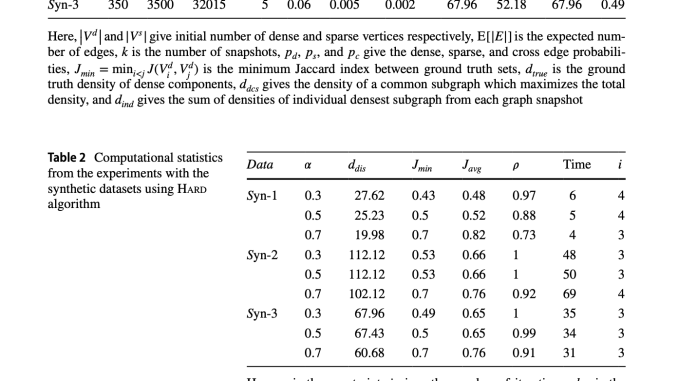
Early work established polynomial-time algorithms for finding the densest subgraph, followed by explorations of size-constrained variants and extensions to multiple graph snapshots. Researchers have also investigated overlapping dense subgraphs and alternative density measures. Various algorithmic approaches, including greedy and iterative methods, have been developed to address these challenges. The paper builds on this foundation by introducing pairwise Jaccard similarity constraints across graph snapshots, expanding the field’s application to temporal networks.
Researchers from the University of Helsinki explored the challenge of finding dense subgraphs in temporal networks, focusing on subgraphs with high Jaccard similarity. Their goal was to maximize total density while maintaining a minimum similarity threshold. Given the problem’s NP-hard nature, they developed an efficient greedy algorithm based on vertex and edge count and explored an alternative approach incorporating Jaccard indices in the objective function. Experiments on both synthetic and real-world data demonstrated the effectiveness of their algorithms, highlighting the importance of this work in graph mining and its various applications across different fields.
The paper addresses the challenge of finding dense subgraphs in temporal networks, a crucial issue in graph mining with applications across various fields. It focuses on evolving networks, introducing the concept of graph snapshots. The authors define density as the ratio of induced edges to vertices, enabling efficient algorithms. They propose a novel approach that balances between finding a common dense subgraph across snapshots and identifying independent dense subgraphs for each snapshot.
This paper introduces two main problems in temporal network analysis: Jaccard Constrained Dense Subgraph Discovery (JCDS) and Jaccard Weighted Dense Subgraph Discovery (JWDS). For JCDS, the authors developed a greedy, iterative algorithm running in O(nk² + m) time. For JWDS, they created both iterative and greedy algorithms with O(n²k² + m log n + k³n) time complexity per iteration.
The research validates these algorithms through experiments on synthetic and real-world datasets, demonstrating their effectiveness in finding dense subgraphs while maintaining Jaccard similarity. Case studies further illustrate the practical applicability of their methods. This approach contributes significantly to addressing challenges in analyzing dynamic networks balancing density optimization with temporal consistency constraints.
The experiments in this study demonstrated the effectiveness of the proposed algorithms in discovering dense subgraphs within temporal networks. The HarD algorithm consistently achieved densities comparable to or exceeding ground truth densities across all synthetic datasets. High overlap between discovered sets and ground truth was observed, with Jaccard indices of at least 0.97, indicating accurate subgraph identification.
The algorithms showed adaptability to parameter changes, with increasing density and minimum Jaccard index as parameters increased. In real-world datasets, the HarD algorithm converged efficiently, typically within five iterations. Case studies on Twitter hashtags and co-authorship networks further illustrated the algorithms’ practical utility in analyzing dynamic networks, confirming their value for temporal network analysis while maintaining Jaccard constraints.
Further, The study compares two algorithms, Itr and GrD, which show similar performance in discovering dense subgraphs, with Itr being more efficient, especially on real-world datasets. Experiments reveal how parameter adjustments significantly impact discovered densities and Jaccard coefficients. The algorithms prove robust in both synthetic datasets and real-world applications, such as analyzing Twitter trends and DBLP co-authorships. Their iterative nature allows for continuous improvement, converging to high-quality solutions efficiently.
In conclusion, this paper presents groundbreaking approaches to dense subgraph discovery in temporal networks. The research introduces two novel problems: Jaccard Constrained Dense Subgraph (JCDS) and Jaccard Weighted Dense Subgraph (JWDS) discovery. Both aim to find dense vertex subsets across multiple graph snapshots while considering Jaccard index constraints. Proving these problems NP-hard, the authors develop efficient heuristic algorithms for each. Extensive experiments on synthetic and real-world datasets demonstrate the algorithms’ effectiveness in discovering dense collections and identifying ground truth. The study explores the impact of user-defined parameters on results, contributing significantly to graph mining research. These findings offer new approaches for analyzing temporal networks and suggest promising directions for future exploration in this field.
Check out the Paper. All credit for this research goes to the researchers of this project. Also, don’t forget to follow us on Twitter and join our Telegram Channel and LinkedIn Group. If you like our work, you will love our newsletter..
Don’t Forget to join our 47k+ ML SubReddit
Find Upcoming AI Webinars here

Shoaib Nazir is a consulting intern at MarktechPost and has completed his M.Tech dual degree from the Indian Institute of Technology (IIT), Kharagpur. With a strong passion for Data Science, he is particularly interested in the diverse applications of artificial intelligence across various domains. Shoaib is driven by a desire to explore the latest technological advancements and their practical implications in everyday life. His enthusiasm for innovation and real-world problem-solving fuels his continuous learning and contribution to the field of AI






Be the first to comment